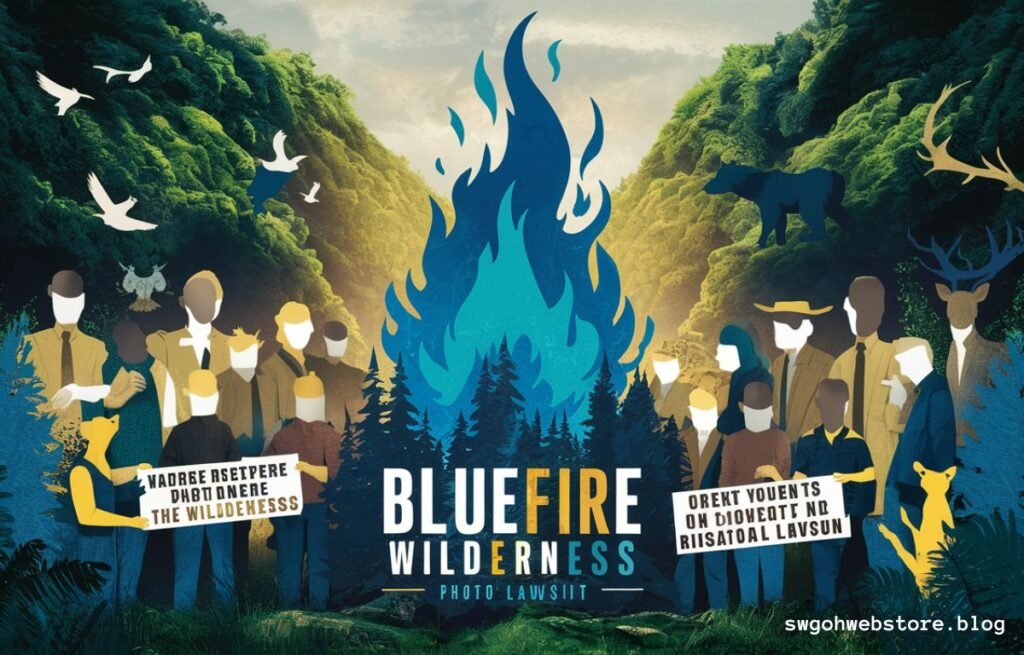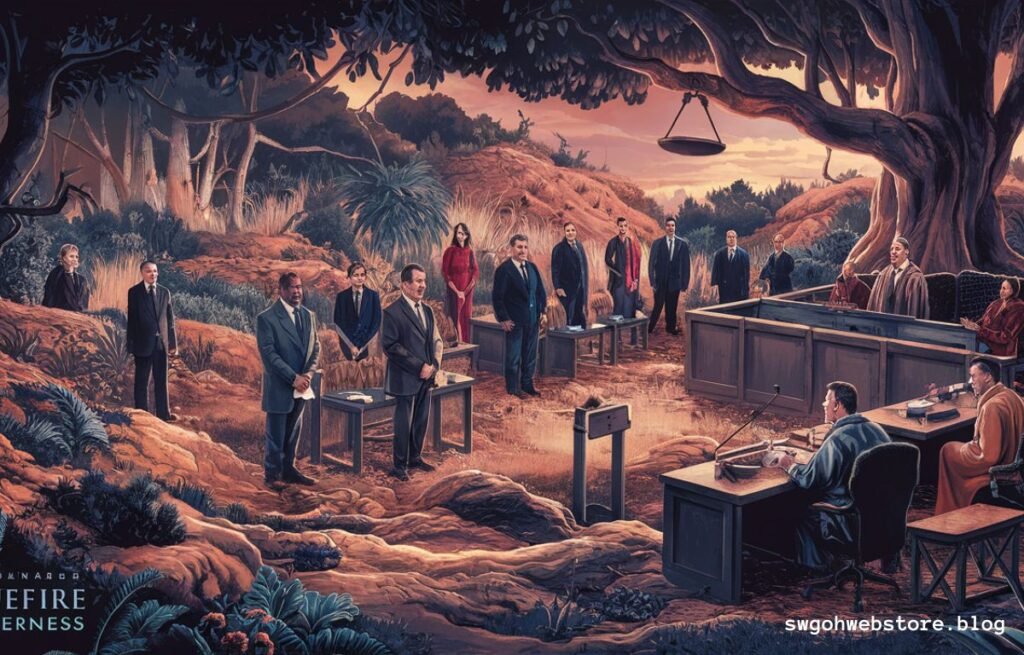When it comes to wilderness therapy programs, Bluefire Wilderness is a name that often comes up. Known for its commitment to helping troubled teens, the program has built a solid reputation. However, like many organizations, it has faced its share of legal issues. In this article, we’ll dive deep into the Bluefire Wilderness lawsuit, shedding light on the events, key players, and potential implications for the industry.
Introduction to Bluefire Wilderness and the Lawsuit
Bluefire Wilderness is a well-known program that helps teenagers facing challenges. Recently, it got into trouble with a lawsuit. This lawsuit brought up serious issues and caused a lot of controversy.
The lawsuit claimed that Bluefire Wilderness didn’t take good care of its students. Some families and former students said they experienced neglect and mistreatment. They accused the program of not watching over the students properly. This made many people question if the program was safe.
Reports said students were sometimes punished by being denied basic things like food and water. There were also accusations of staff members using physical restraints too much. This raised concerns about how well the staff was trained to handle difficult situations.
The lawsuit made people look closely at how programs like Bluefire Wilderness operate. It raised important questions about the safety and treatment of teenagers in these types of programs. The outcome of this lawsuit could have a big impact on how such programs are run in the future.
Impact on Families and Former Students
The lawsuit against Bluefire Wilderness has deeply affected families and former students. Families who trusted the program are now unsure about the care their loved ones received. They worry about whether the program really helped or caused harm.
Former students have mixed feelings too. Some feel validated because their experiences match the allegations in the lawsuit. They might feel relieved that their concerns are being taken seriously. Others feel disappointed or betrayed if they believed in the program’s methods.
Conversations among families and former students have become difficult. They’re discussing what happened and what it means for others considering similar programs. Many are realizing the importance of researching programs thoroughly before trusting them with their loved ones’ well-being.
The lawsuit serves as a reminder of how important it is to ensure safety and accountability in programs like Bluefire Wilderness. It’s prompting discussions about how to improve these programs so they can better support struggling teens. Moving forward, transparency and honesty will be crucial in rebuilding trust in this industry.
People are hoping that the outcome of the lawsuit brings positive changes. They want to see improvements in how these programs operate, ensuring they provide a safe and supportive environment for all participants.
Response from Bluefire Wilderness

When Bluefire Wilderness learned about the lawsuit, they quickly responded. They wanted to address the serious allegations that were made against them. In their response, they emphasized their commitment to the safety and well-being of all students in their care.
Bluefire Wilderness acknowledged the gravity of the situation. They promised to cooperate fully with the legal proceedings. This showed they were taking the allegations seriously and wanted to resolve them openly.
The program highlighted their dedication to always improving. They said they follow the best practices in their industry. This reassured families that they were committed to providing the best possible care for their students.
They also stressed the importance of transparency. They promised to openly discuss any issues that come up. This was meant to build trust with families and show that they take concerns seriously.
Overall, Bluefire Wilderness’s response aimed to assure families and the community that they were focused on providing safe and effective therapeutic support for every participant.
Legal Proceedings and Outcome
After the allegations against Bluefire Wilderness came to light, legal actions quickly followed. The lawsuit brought by former students and families shed light on how the program operated. Both sides presented their arguments in court, which created a lot of tension and uncertainty.
Everyone involved eagerly awaited the outcome of the lawsuit. Finally, a decision was reached. This marked a significant moment for Bluefire Wilderness and everyone affected by its actions. The results of this legal battle had a big impact on the troubled teen industry as a whole.
Some people hoped the lawsuit would bring closure to those affected. Others wanted to see changes in how programs like Bluefire Wilderness are run. Lessons were learned, and it became clear that more accountability was needed in these types of programs.
The legal proceedings served as a catalyst for reflection and growth within Bluefire Wilderness. They started looking at ways to make improvements and ensure something like this wouldn’t happen again. It was a challenging time, but it prompted important discussions and changes within the organization.
Also Read: Geekzilla Radio: The Ultimate Hub for Geek Culture
Lessons Learned and Changes Made by Bluefire Wilderness
The lawsuit against Bluefire Wilderness prompted the program to reflect deeply on its practices and make significant improvements. The allegations highlighted areas where the program needed to do better in terms of staff training and oversight.
As a result, Bluefire Wilderness implemented stricter protocols for how staff interact with students. They increased supervision to ensure the safety and well-being of every participant. These changes aimed to create a more supportive and secure environment.
Communication with families also improved. Bluefire Wilderness committed to being more transparent about their methods and outcomes. They wanted families to feel confident and informed about the care their loved ones were receiving.
Furthermore, the program invested more resources in therapeutic support. They expanded their aftercare services to better assist students as they transitioned back to their normal lives. These efforts were designed to provide comprehensive support beyond the wilderness experience.
Overall, the experience served as a turning point for Bluefire Wilderness. It reinforced their commitment to providing effective treatment while prioritizing the welfare of their students. Through these changes, they aimed to rebuild trust and uphold high standards of care in the troubled teen industry.
Key Players in the Lawsuit
In the lawsuit against Bluefire Wilderness, several key players were involved, each playing a significant role in the unfolding events:
Former Students and Families: These individuals were the plaintiffs in the lawsuit, bringing forward allegations of neglect, abuse, and mistreatment against Bluefire Wilderness. Their testimonies and experiences were central to the case, highlighting the impact of the program’s practices on their lives.
Bluefire Wilderness: As the defendant, Bluefire Wilderness was at the center of the allegations. The program’s response to the lawsuit, including their statements and actions taken during legal proceedings, shaped the narrative and response to the accusations.
Legal Counsel: Lawyers representing both the plaintiffs (former students and families) and the defendant (Bluefire Wilderness) played crucial roles in presenting arguments, examining evidence, and advocating for their respective clients’ interests in court.
Court Officials: Judges and court officials presiding over the case were responsible for overseeing proceedings, ruling on legal matters, and ultimately issuing a verdict based on the presented evidence and arguments.
Public and Media: The lawsuit garnered public attention and media coverage, influencing public perception and awareness of issues within the troubled teen industry. Media outlets reported on developments, providing information and analysis to the broader community.
Support Networks and Advocacy Groups: Various support networks and advocacy groups, including those focused on youth welfare and legal advocacy, offered support to plaintiffs and facilitated public discussions on the broader implications of the case.
These key players collectively shaped the course of the lawsuit, influencing its outcomes and contributing to discussions about accountability, transparency, and the ethical standards of wilderness therapy programs like Bluefire Wilderness.
Impact on Bluefire Wilderness
The impact of the lawsuit on Bluefire Wilderness has been profound and multifaceted:
Reputation: The lawsuit has significantly tarnished Bluefire Wilderness’s reputation. Allegations of neglect and mistreatment have raised serious concerns among potential clients and their families about the safety and efficacy of the program.
Operational Changes: In response to the lawsuit, Bluefire Wilderness has had to make substantial operational changes. This includes revising protocols for staff training, supervision, and disciplinary measures to ensure compliance with best practices and legal standards.
Financial Impact: Legal fees and potential settlements associated with the lawsuit have likely placed a financial strain on Bluefire Wilderness. Moreover, the negative publicity and decreased enrollment due to reputational damage may have affected their financial stability.
Internal Reflection: The lawsuit has prompted internal reflection within Bluefire Wilderness. It has served as a catalyst for evaluating their treatment methods, enhancing transparency, and improving communication with stakeholders, including families and regulatory bodies.
Industry Influence: The outcomes of the lawsuit have influenced industry standards and practices within the troubled teen industry. Bluefire Wilderness’s responses and changes may set precedents for other programs to improve accountability and ensure the well-being of their participants.
Overall, the lawsuit against Bluefire Wilderness has had a profound impact on its operations, reputation, and the broader industry landscape. It underscores the importance of accountability and transparency in therapeutic programs catering to vulnerable populations.
Industry-Wide Implications

The lawsuit against Bluefire Wilderness carries significant industry-wide implications:
Regulatory Scrutiny: Regulatory bodies and authorities may increase scrutiny and oversight over wilderness therapy programs. The lawsuit highlighted gaps in supervision, training, and safety protocols, prompting calls for stricter regulations to protect participants.
Consumer Awareness: Families and individuals seeking therapeutic programs for troubled teens are now more aware of potential risks and challenges within the industry. The lawsuit has underscored the importance of thorough research and due diligence before selecting a program.
Ethical Standards: There is a growing emphasis on ethical standards and practices within the troubled teen industry. Programs like Bluefire Wilderness may face pressure to adopt and adhere to rigorous ethical guidelines to regain trust and credibility.
Legal Precedent: The outcomes of the lawsuit could set legal precedents for future cases involving similar allegations against wilderness therapy programs. Legal decisions and settlements may shape how such programs operate and are held accountable.
Industry Reform: The lawsuit has sparked conversations and initiatives aimed at reforming the troubled teen industry. Stakeholders, including advocacy groups and policymakers, may advocate for systemic changes to ensure the safety and well-being of participants.
Overall, the lawsuit against Bluefire Wilderness has prompted broader discussions about accountability, transparency, and ethical practices within the troubled teen industry. It serves as a pivotal moment for addressing systemic issues and improving standards of care for vulnerable youth in therapeutic settings.
Also Read: Unlocking the Digital World with AIOTechnical.com
Lessons Learned
The lawsuit against Bluefire Wilderness has yielded several important lessons:
Importance of Oversight: It underscored the critical need for robust oversight and regulatory scrutiny in therapeutic wilderness programs. Clear guidelines and enforcement mechanisms are essential to ensure the safety and well-being of participants.
Transparency Builds Trust: The case highlighted the significance of transparency in operations. Open communication about practices, policies, and outcomes fosters trust with families and stakeholders, promoting accountability.
Impact of Training and Supervision: It emphasized the pivotal role of comprehensive staff training and adequate supervision. Properly trained staff and effective supervision are crucial in maintaining a safe and supportive environment for participants.
Listening to Participant Experiences: Listening to and addressing participant experiences and concerns is essential. The lawsuit emphasized the importance of taking participant feedback seriously and making necessary improvements based on their experiences.
Continuous Improvement: Continuous evaluation and improvement of program practices are vital. Programs must adapt and evolve to meet evolving standards and best practices in the industry, ensuring quality care and ethical treatment.
Legal Preparedness: Programs must be prepared to respond swiftly and effectively to legal challenges. Prompt and transparent responses to allegations can help mitigate reputational damage and demonstrate commitment to accountability.
These lessons from the lawsuit against Bluefire Wilderness provide valuable insights for the troubled teen industry and highlight areas for improvement to better serve vulnerable youth and their families.
Moving Forward
Moving forward, several key actions can help the troubled teen industry, including programs like Bluefire Wilderness, navigate challenges and improve:
Enhanced Transparency: Commit to transparency by openly sharing program practices, policies, and outcomes with families and stakeholders. This builds trust and demonstrates accountability.
Stricter Oversight and Standards: Advocate for and adhere to stricter oversight and industry standards. Implement rigorous guidelines for staff training, supervision, and participant safety to ensure compliance and ethical conduct.
Continuous Evaluation and Improvement: Continuously evaluate and improve program practices based on participant feedback, industry best practices, and regulatory requirements. Embrace a culture of continuous improvement to enhance program effectiveness.
Strengthened Staff Training: Invest in comprehensive staff training programs that prioritize empathy, effective communication, and crisis management. Equip staff with the skills and knowledge needed to support participants safely and compassionately.
Collaboration and Advocacy: Collaborate with industry stakeholders, including regulatory bodies, advocacy groups, and professionals, to advocate for systemic improvements and ethical standards within the troubled teen industry.
Supportive Aftercare and Follow-up: Expand aftercare services to provide ongoing support for participants and their families after they leave the program. Ensure continuity of care and resources to facilitate successful transitions back to everyday life.
By implementing these strategies, programs like Bluefire Wilderness can contribute to a safer and more supportive environment for participants, uphold ethical standards, and rebuild trust with families and the broader community. These actions pave the way for positive change and advancement within the troubled teen industry.
Conclusion: The Importance of Transparency and Accountability
In the troubled teen industry, transparency and accountability are crucial. Programs like Bluefire Wilderness must uphold the highest standards of care to ensure the well-being of their young participants. Transparency means being open about their practices, policies, and outcomes.
The lawsuit against Bluefire Wilderness underscored the need for oversight and accountability in these programs. It highlighted the importance of thoroughly investigating allegations to protect vulnerable youth from harm. Moving forward, it’s essential for wilderness therapy programs to prioritize transparency and adhere to best practices.
By prioritizing transparency, programs can build trust with families seeking help for their loved ones in crisis. This commitment not only safeguards the well-being of students but also strengthens ethical standards within the troubled teen industry. It sets a precedent for continuous improvement and ensures that these programs provide a safe and supportive environment for all participants.

FAQs about Bluefire Wilderness Lawsuit
What is Bluefire Wilderness Therapy?
Bluefire Wilderness Therapy is a therapeutic program for adolescents struggling with emotional, behavioral, and mental health issues. It uses a combination of adventure therapy, clinical interventions, and family involvement, set in a wilderness environment.
What was the Bluefire Wilderness lawsuit about?
The lawsuit involved allegations of negligence, abuse, and inadequate training of staff. Plaintiffs claimed that Bluefire Wilderness failed to provide a safe and supportive environment for the participants.
Who filed the lawsuit against Bluefire Wilderness?
The lawsuit was typically filed by parents or guardians of teens who attended the program and felt their children were harmed or neglected during their stay.
What were the main allegations in the lawsuit?
The main allegations included:
- Negligence in providing care and supervision.
- Physical and emotional abuse by staff members.
- Inadequate training of staff to handle the unique needs of troubled teens.
Also Read: ExplOre puppy:1azdln0ha3y= golden retriever
How did Bluefire Wilderness respond to the allegations?
Bluefire Wilderness defended its practices, emphasizing its commitment to participant safety and the positive outcomes achieved by many of its participants. They also implemented changes to policies and procedures to address the concerns raised.
What were the outcomes of the lawsuit?
The specific outcomes of the lawsuit can vary, including potential settlements, changes in operational practices, and reputational impact on the organization.
What impact did the lawsuit have on Bluefire Wilderness?
The lawsuit led to reputational damage, financial strain due to legal fees, and operational changes aimed at improving safety and transparency.
How did the lawsuit affect the wilderness therapy industry?
The lawsuit highlighted the need for stricter regulations, improved training for staff, and greater transparency within the wilderness therapy industry as a whole.
What steps has Bluefire Wilderness taken post-lawsuit?
Post-lawsuit, Bluefire Wilderness has focused on enhancing safety measures, improving staff training, and maintaining open communication with families to rebuild trust and ensure participant well-being.
Is Bluefire Wilderness still in operation?
Yes, despite the challenges posed by the lawsuit, Bluefire Wilderness continues to operate, striving to learn from past mistakes and improve its services for troubled teens and their families.
How can parents ensure a wilderness therapy program is safe?
Parents should research programs thoroughly, ask about staff training and qualifications, understand the program’s policies and procedures, and seek feedback from former participants and their families.
What lessons can the industry learn from the Bluefire Wilderness lawsuit?
Key lessons include prioritizing participant safety, enhancing staff training, maintaining transparency, and continuously reviewing and updating operational policies to prevent similar issues in the future.

Emily, an 8-year veteran, blends tech savvy with wanderlust. His fashion-forward perspective and business acumen create captivating content. Explore realms where innovation meets style.